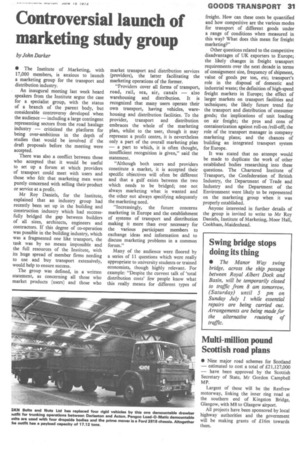Controversial launch of marketing study group
Page 33

If you've noticed an error in this article please click here to report it so we can fix it.
by John Darker
• The Institute of Marketing, with 17,000 members, is anxious to launch a marketing group for the transport and distribution industry.
An inaugural meeting last week heard speakers from the Institute argue the case for a specialist group, with the status of a branch of the parent body, but considerable controversy developed when the audience — including a large contingent representing sectors from the road haulage industry — criticized the platform for being over-ambitious in the depth of studies that would be involved if the draft proposals before the meeting were accepted.
There was also a conflict between those who accepted that it would be useful to set up a forum at which providers of transport could meet with users and those who felt that marketing men were purely concerned with selling their product or service at a profit.
Mr Roy Daniels, for the Institute, explained that an industry group had recently been set up in the building and construction industry which had successfully bridged the gap between builders of all sizes, architects, engineers and contractors. If this degree of co-operation was possible in the building industry, which was a fragmented one like transport, the task was by no means impossible and the full resources of the Institute, with its huge spread of member firms needing to use and buy transport extensively, would help to ensure success.
The group was defined, in a written statement, as concerning all those who market products (users) and those who market transport and distribution services (providers), the latter facilitating the marketing operations of the former.
"Providers cover all forms of transport, road, rail, sea, air, canals — also warehousing and distribution. It is recognized that many users operate their own transport, having vehicles, warehousing and distribution facilities. To the provider, transport and distribution embraces the whole of the marketing plan, whilst to the user, though it may represent a profit centre, it is nevertheless only a part of the overall marketing plan — a part to which, it is often thought, insufficient recognition is given," said the statement.
"Although both users and providers constitute a market, it is accepted their specific objectives will often be different and that a gulf exists between the two which needs to be bridged; one not always marketing what is wanted and the other not always specifying adequately the marketing need.
"Increasingly, the future concerns marketing in Europe and the establishment of systems of transport and distribution making it more than ever necessary for the various participant members to exchange ideas and information and to discuss marketing problems in a common forum."
Many of the audience were floored by a series of 11 questions which were really appropriate to university students or trained economists, though highly relevant. For example: "Despite the current talk of 'total distribution costs' few people know what this really means for different types of freight. How can these costs be quantified and how competitive are the various modes for transport of different goods under a range of conditions when measured in this way? What does this mean for freight marketing?"
Other questions related to the competitive disadvantages of UK exporters to Europe; the likely changes in freight transport requirements over the next decade in terms of consignment size, frequency of shipment, value of goods per ton, etc; transport's role in the disposal of domestic and industrial waste; the definition of high-speed freight markets in Europe; the effect of larger markets on transport facilities and techniques; the likely future trend for the transport and distribution of consumer goods; the implications of unit loading on air freight; the pros and cons of containerization against roll-on /roll-off; the role of the transport manager in company marketing plans; and the chances of building an integrated transport system for Europe.
It was stated that no attempt would be made to duplicate the work of other established bodies researching into these questions. The Chartered Institute of Transport, the Confederation of British Industry, the Department of Trade and Industry and the Department of the Environment were likely to be represented on the marketing group when it was properly established.
Anyone interested in further details of the group is invited to write to Mr Roy Daniels, Institute of Marketing, Moor Hall, Cookham, Maidenhead.












































































































































